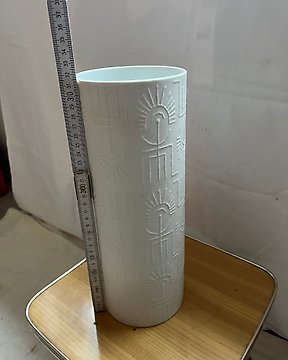
Rosenthal - Jarra - Cuno Fischer - Porcelana
N.º 82310035

N.º 82310035

In the vibrant world of the 1960s - 1970s design, Martin Freyer emerged as a prominent figure with his remarkable creations for Rosenthal, the distinguished German manufacturer. Collaborating with Rosenthal, Freyer embraced the captivating style of op art, translating its mesmerizing optical illusions into delicate porcelain masterpieces. The op art porcelain vase, produced during the 1960s in Germany, judging by the golden S logo, stands as a testament to this era's design ethos. Crafted with precision and skill, this vase showcases Rosenthal's legacy in porcelain craftsmanship and Freyer's creative genius.
Op art, short for Optical Art, celebrated the power of optical illusions and visual trickery, captivating audiences with mind-bending compositions. Freyer, in collaboration with Rosenthal, merged this captivating style with the delicate nature of porcelain. The result was a series of exquisite vases that seamlessly played with lines, shapes, and patterns, inviting viewers to explore the boundaries of perception. This particular vintage op art vase, an exceptional piece, invites viewers into an optical dance as they observe its shifting and transforming patterns.
At the base of the vase, one finds the unmistakable mark of Rosenthal, symbolizing the brand's legacy in fine porcelain.
Pay attention that the stamp also presents the artist's signature.
Freyer's minimalistic and straightforward design language, characteristic of the 1970s, reflects the era's fascination with simplicity and clean lines. Standing at 43 centimetres in height and 14×10 at width, this op art vase possesses a commanding presence, capable of enhancing the aesthetic of any modern home.
In remarkably good condition, this vintage op art vase showcases a patina, adding authenticity and reflecting the passage of time. It is a reminder of the unique journey and story of each object. Obviously it may show some traces of time and slight wear, consistent with normal use of decorative objects.
The collaboration between Martin Freyer and Rosenthal during the 1960s - 1970s left an indelible mark on the world of design. Their ability to merge op art principles with porcelain exemplified their mastery in blending form and function. Beyond this op art vase, their collective efforts have resulted in a catalogue of timeless designs that continue to inspire designers and collectors, embodying the spirit of innovation and artistic exploration that defined the era.
***The designer***
Hans Martin Freyer (1909-1975) was a German painter and designer. He was born in Hanover, Germany, and studied at the at the Technische Universität Darmstadt (Darmstadt University of Technology). In 1933, he spent time in the Balkans, Italy, France, and Switzerland. After returning to Germany, he studied at the Universität der Künste Berlin (University of Art Berlin) and the Reimann School in Berlin.
From 1937 to 1938, Freyer worked as a landscape architect, interior designer, and set designer in the US. Upon his return to Germany, he designed the Volkswagen logo. During the Second World War, Freyer worked as an art designer for stage productions of opera houses, cabaret stages, and variety shows.
Throughout his career, Freyer also worked as a portrait artist, as well as a graphic and industrial designer for surface decorations and structures. He created designs for wallpapers, textiles, decorative materials, and light metal. From 1964 to 1974, he designed for Rosenthal Porcelain, developing relief decorations for glass and porcelain vases of the studio-line.
***sum up***
Designer: Martin Freyer
Manufacturer: Rosenthal
Production year: 1964 +/-
Country of Manufacture: Germany
West German Pottery WGP
Identifying Marks: This piece has an attribution mark of the manufacturer as for signature of the designer
Style: Vintage, Mid-Century Modern, Op Art
Detailed Condition: Very Good to Excellent — This vintage item has no defects.
It may show slight traces of time and use, as reasonable patina and such.
Material: Bisque porcelain
Colour: White, matte outside, glossy inside
Height: 43 cm (very rare!)
---
Check out my profile for much more retro vases!
Please pay attention that shipping costs are determined over the app function
I try to describe all the items as accurately and as honestly as possible, and I always include photos of the actual items.
There can be naturally occurring manufacturer's defects, slight surface scratching, or wear consistent with normal use.
Any condition outside normal vintage wear, like chips or cracks or serious defaults, will be noted and/or clearly visible on the photos.
Most importantly: this is a transaction between a private seller and a private buyer of secondhand items, so no refunds or returns are accepted, nor any claims of guarantee or similar services.
#collectorsboho
Como comprar na Catawiki
1. Descubra algo especial
2. Faça a licitação vencedora
3. Faça um pagamento seguro